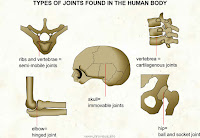First listen to the presentation: The skeletomuscular system
1. What four tissues does a long bone consist of?
ANSWER: subchondral; cancellous; compact; marrow.
2. How many bones are there in the adult skeleton? What are the two major divisions of the skeleton and which mineral is found in bones?
ANSWER: 206; axial & appendicular; calcium phosphate.
3. Name two parts of the axial skeleton and two parts of the appendicular skeleton.
ANSWER: axial: skull, spine, ribs; appendicular: pelvis, shoulders (clavicles and scapulae); limbs.
4. Excluding the jaws and other small bones, name the four largest bones of the skull that enclose the cranium.
ANSWER: frontal; parietal; temporal; occiptal.
5. In addition to the coccyx, what are the four regions of the spine, in order, from the top?
ANSWER: cervical; thoracic; lumbar; sacral.
6. What does a joint do and name the three types?
ANSWER: allows movement (articulation) between bones; fibrous, cartilaginous, synovial.
7. In addition to the hinge joint, name four other types of synovial joint.
ANSWER: pivot; condylar; plane; ball & socket.
8. What are the four movements of an angular joint?
ANSWER: flexion; extension; abduction; adduction.
9. Name the three types of muscle; which one is also described as 'striped' or 'striated'?
ANSWER: skeletal; cardiac; smooth. Skeletal is striped or striated.
10. What are the two types of contractile protein and where are they contained? What is used in the process of contraction?
ANSWER: actin; myosin. Muscle fibre or cells. ATP/Energy.
11. Describe what happens at a neuromuscular junction.
ANSWER: An action potential is transmitted to the muscle via a motor nerve; the electrical signal is transmitted to the muscle chemically (acetyl choline) across the gap between the nerve and the muscle; an action potential is generated in the muscle; the acetyl choline is broken down and/or taken back up into the nerve ending.
12. What are the ends of a skeletal muscle called where it joins to the skeleton? What joins the muscle to the bone and what is it made of?
ANSWER: Origin and insertion; tendon, made of collagen.
13. Which two muscles of the arm control the movement of the lower arm? How would you describe the relative position of these muscles and which one is responsible for extending the arm?
ANSWER: bicep & tricep; opposing; tricep.













sefull for ortho end postings! Thx!
ReplyDeleteThanks for the comment on the blob and apologies for taking a long time to reply
Delete